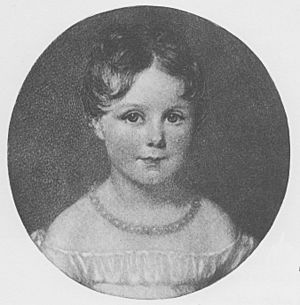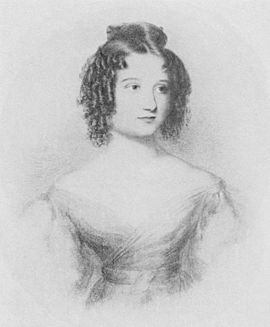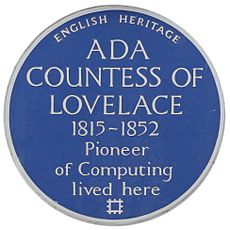Ada Lovelace facts for kids
Quick facts for kids
The Countess of Lovelace
|
|
|---|---|

Daguerreotype by Antoine Claudet (c. 1843). One of only two known photographs.
|
|
| Born |
The Hon. Augusta Ada Byron
10 December 1815 London, England
|
| Died | 27 November 1852 (aged 36) Marylebone, London, England
|
| Resting place | Church of St. Mary Magdalene, Hucknall, Nottingham, England |
| Known for | Mathematics, computing |
| Spouse(s) | |
| Children |
|
| Parent(s) |
|
| Signature | |
Augusta Ada King, Countess of Lovelace (née Byron; 10 December 1815 – 27 November 1852) was an English mathematician and writer. She is often regarded as the first computer programmer.
Contents
Early life
Ada Lovelace was the only legitimate child of poet Lord Byron and reformer Anne Isabella Milbanke. Lord Byron expected his child to be a "glorious boy" and was disappointed when Lady Byron gave birth to a girl. Byron separated from his wife a month after Ada was born and left England forever. He died in Greece when she was eight.

Lovelace was often ill, beginning in early childhood. At the age of eight, she experienced headaches that obscured her vision. In June 1829, she was paralyzed after a bout of measles. She was subjected to continuous bed rest for nearly a year, something which may have extended her period of disability. By 1831, she was able to walk with crutches. Despite the illnesses, she developed her mathematical and technological skills.
Education
From 1832, when she was seventeen, Lovelace's mathematical abilities began to emerge, and her interest in mathematics dominated the majority of her adult life. She was privately educated in mathematics and science by William Frend, William King, and Mary Somerville, the noted 19th-century researcher and scientific author. In the 1840s, the mathematician Augustus De Morgan extended her "much help in her mathematical studies" including study of advanced calculus topics.
Work
Throughout her life, Lovelace was strongly interested in scientific developments. After her work with Babbage, Lovelace continued to work on other projects. In 1844, she commented to a friend Woronzow Greig about her desire to create a mathematical model for how the brain gives rise to thoughts and nerves to feelings ("a calculus of the nervous system"). She never achieved this, however.
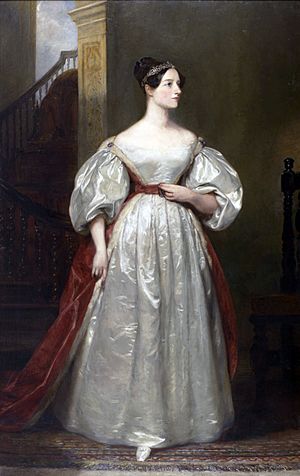
Lovelace first met Charles Babbage in June 1833, through their mutual friend Mary Somerville. Later that month, Babbage invited Lovelace to see the prototype for his difference engine. She became fascinated with the machine and used her relationship with Somerville to visit Babbage as often as she could. Babbage was impressed by Lovelace's intellect and analytic skills. He called her "The Enchantress of Number".
During a nine-month period in 1842–43, Lovelace translated the Italian mathematician Luigi Menabrea's article on Babbage's newest proposed machine, the Analytical Engine. With the article, she appended a set of notes. Explaining the Analytical Engine's function was a difficult task; many other scientists did not grasp the concept and the British establishment had shown little interest in it. Lovelace's notes even had to explain how the Analytical Engine differed from the original Difference Engine. Her work was well received at the time.
The notes are around three times longer than the article itself and were labelled alphabetically from A to G. In note G, she describes an algorithm for the Analytical Engine to compute Bernoulli numbers. The engine has now been recognised as an early model for a computer and her notes as a description of a computer and software. Based on this work, Lovelace is now considered by many to be the first computer programmer and her method has been called the world's first computer program. The engine, however, was never completed and so her program was never tested.

Death
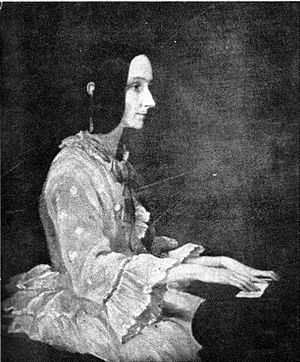
Lovelace died at the age of 36 on 27 November 1852, from cancer. She was buried, at her request, next to her father at the Church of St. Mary Magdalene in Hucknall, Nottinghamshire. A memorial plaque, written in Latin, to her and her father is in the chapel attached to Horsley Towers.
Personal life
On 8 July 1835, Lovelace married William, 8th Baron King, becoming Lady King. They had three homes: Ockham Park, Surrey; a Scottish estate on Loch Torridon in Ross-shire; and a house in London. From 1845, the family's main house was Horsley Towers, built in the Tudorbethan fashion by the architect of the Houses of Parliament, Charles Barry, and later greatly enlarged to Lovelace's own designs.
The couple had three children: Byron (born 1836); Anne Isabella (called Annabella, born 1837); and Ralph Gordon (born 1839).
Commemoration
In 1981, the Association for Women in Computing inaugurated its Ada Lovelace Award. Since 1998, the British Computer Society (BCS) has awarded the Lovelace Medal, and in 2008 initiated an annual competition for women students. BCSWomen sponsors the Lovelace Colloquium, an annual conference for women undergraduates. Ada College is a further-education college in Tottenham Hale, London, focused on digital skills.
Ada Lovelace Day is an annual event celebrated on the second Tuesday of October, which began in 2009. Its goal is to "... raise the profile of women in science, technology, engineering, and maths," and to "create new role models for girls and women" in these fields. Events have included Wikipedia edit-a-thons with the aim of improving the representation of women on Wikipedia in terms of articles and editors to reduce unintended gender bias on Wikipedia.
The Ada Initiative was a non-profit organisation dedicated to increasing the involvement of women in the free culture and open source movements.
The Engineering in Computer Science and Telecommunications College building in Zaragoza University is called the Ada Byron Building. The computer centre in the village of Porlock, near where Lovelace lived, is named after her. Ada Lovelace House is a council-owned building in Kirkby-in-Ashfield, Nottinghamshire, near where Lovelace spent her infancy.
In 2013, Ada Developers Academy was founded and named after her. The mission of Ada Developers Academy is to diversify tech by providing women and gender diverse people the skills, experience, and community support to become professional software developers to change the face of tech.
As of November 2015, all new British passports have included an illustration of Lovelace and Babbage.
On 2 February 2018, Satellogic, a high-resolution Earth observation imaging and analytics company, launched a ÑuSat type micro-satellite named in honour of Ada Lovelace.
On 27 July 2018, Senator Ron Wyden submitted, in the United States Senate, the designation of 9 October 2018 as National Ada Lovelace Day: "To honor the life and contributions of Ada Lovelace as a leading woman in science and mathematics". The resolution (S.Res.592) was considered, and agreed to without amendment and with a preamble by unanimous consent.
In November 2020 it was announced that Trinity College Dublin whose library had previously held forty busts, all of them of men, was commissioning four new busts of women, one of whom was to be Lovelace.
In March 2022, a statue of Ada Lovelace was installed at the site of the former Ergon House in the City of Westminster, London, honoring its scientific history. The redevelopment was part of a complex with Imperial Chemical House. The statue was sculpted by Etienne and Mary Millner and based on the portrait by Margaret Sarah Carpenter. The sculpture was unveiled on International Women's Day, 2022. It stands on the 7th floor of Millbank Quarter overlooking the junction of Dean Bradley Street and Horseferry Road.
In September 2022, Nvidia announced the Ada Lovelace graphics processing unit (GPU) microarchitecture.
Bicentenary
The bicentenary of Ada Lovelace's birth was celebrated with a number of events, including:
- The Ada Lovelace Bicentenary Lectures on Computability, Israel Institute for Advanced Studies, 20 December 2015 – 31 January 2016.
- Ada Lovelace Symposium, University of Oxford, 13–14 October 2015.
- Ada.Ada.Ada, a one-woman show about the life and work of Ada Lovelace (using an LED dress), premiered at Edinburgh International Science Festival on 11 April 2015, and continues to touring internationally to promote diversity on STEM at technology conferences, businesses, government and educational organisations.
Special exhibitions were displayed by the Science Museum in London, England and the Weston Library (part of the Bodleian Library) in Oxford, England.
Publication history
Six copies of the 1843 first edition of Sketch of the Analytical Engine with Ada Lovelace's "Notes" have been located. Three are held at Harvard University, one at the University of Oklahoma, and one at the United States Air Force Academy. On 20 July 2018, the sixth copy was sold at auction to an anonymous buyer for £95,000. A digital facsimile of one of the copies in the Harvard University Library is available online.
Interesting facts about Ada Lovelace
- Lovelace was named after Byron's half-sister, Augusta Leigh, and was called "Ada" by Byron himself.
- She was not shown the family portrait of her father until her 20th birthday.
- Ada's was taught mathematics from an early age because her mother believed it would prevent the girl from developing Lord Byron's perceived insanity.
- Lovelace often questioned basic assumptions through integrating poetry and science.
- She believed that intuition and imagination were critical to effectively applying mathematical and scientific concepts.
- Ada valued metaphysics as much as mathematics, viewing both as tools for exploring "the unseen worlds around us".
- Lovelace was dismissive of artificial intelligence. She wrote that "The Analytical Engine has no pretensions whatever to originate anything. It can do whatever we know how to order it to perform. It can follow analysis; but it has no power of anticipating any analytical relations or truths."
- The computer language Ada, created on behalf of the United States Department of Defense, was named after Lovelace.
See also
 In Spanish: Ada Lovelace para niños
In Spanish: Ada Lovelace para niños


